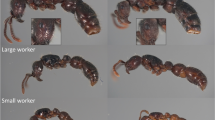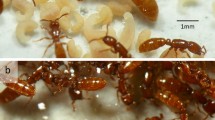Summary
Sociobiological studies were made of the polygynic ant speciesLasius sakagamii Yamauchi et Hayashida. This species has a peculiar polydomous system characterized by 1) intranidal mating, 2) retention of newly emerged queens in the mother nest, resulting in a polygynic colony, 3) reduced territorial behavior, 4) colony multiplication by budding, 5) enlargement of colony size up to several millions of workers, 6) saturation and domination of preferred local habitat. Compared with that of other polydomous species, the polydomous system of this species may be considered relatively undifferentiated or rudimentary, offering valuable materials for the study of the evolution of polydomous systems.
Resume
Les sociétés deLasius sakagamii Yamauchi et Hayashida ont une organisation polycalique particulière, caractérisée par les faits suivants: 1) accouplements entre membres du même nid; 2) maintien des femelles nouvellement écloses dans le nid maternel, donc société polygyne; 3) comportement territorial peu développé; 4) reproduction des sociétés par bourgeonnement; 5) croissance de la société jusqu'à plusieurs millions d'ouvrières; 6) saturation des habitats préférés, et dominance locale. La comparaison avec d'autres espèces de Fourmis polycaliques montre que l'organisation polycalique de l'espèce étudiée est relativement peu différenciée et rudimentaire, et constitue un matériel favorable pour l'étude de l'évolution du système polycalique.
Similar content being viewed by others
References
Brian M.V., 1965. —Social insect populations. Academic Press, London and New York, 135 p.
Brian M.V., Elmes G.W., 1974. — Production by the antTetramorium caespitum in a southern English heath.J. Anim. Ecol., 43, 889–903.
Higashi S., 1976. — Nest proliferation by budding and nest growth pattern inFormica (Formica) yessensis in Ishikari Shore.Jour. Fac. Sci., Hokkaido Univ., Ser. VI, Zool.,20, 359–389.
Higashi S., 1978. — Analysis of internest drifting in a supercolonial antFormica (Formica) yessensis by individually marked workers.Kontyû, Tokyo,46, 176–191.
Ito M., Imamura S., 1974. — Observations on the nuptial flight and internidal relationship in a polydomous ant,Formica (Formica) yessensis Forel.Jour. Fac. Sci., Hokkaido Univ., Ser. VI, Zool.,19, 681–694.
Imamura S., 1976. — Ecology ofFormica yessensis Forel in Ishikari Shore.Anima, 36 13–20 (in Japanese).
Janzen D.H., 1973. — Evolution of polygynous obligate acacia-ants in Western Mexico.J. Anim. Ecol., 42, 727–751.
Marikovsky P.I., 1965. — Colonies of yellow ants (Lasius flavus De Geer) as theatre of struggle between nest colonies of other ant species.Insectes Sociaux, 12, 63–70.
Odum E.P., Pontin A.J., 1961. — Population density of the underground ant,Lasius flavus, as determined by tagging with P32.Ecol., 42, 186–188.
Pickles W., 1940. — Fluctuations in the populations, weights and biomasses of ants at Thornhill, Yorkshire, from 1935–1939.Trans. Roy. Ent. Soc., 90, 467–485.
Pisarski B., 1973. —Les principes d'organisation des colonies polycalliques des fourmis. Proc. VII Congr. IUSSI, London, 311–316.
Pontin A.J., 1961. — Field experiments on colony foundation byLasius niger (L.) andL. flavus (F.) (Hymenoptera, Formicidae).Insectes Sociaux, 7, 227–230.
Pontin A.J., 1961. — Population stabilization and competition between the antsLasius flavus (F.) andL. niger (L.).J. Anim. Ecol., 30, 47–54.
Waloff N., 1957. — The effect of the number of queens of the antLasius flavus (Fab.) (Hym., Formicidae) on their survival and on the rate of development of the first brood.Insectes Sociaux, 4, 391–408.
Waloff N., Blackith R.E., 1962. — The growth and distribution of the mounds ofLasius flavus (Fabricius) (Hym., Formicidae) in Silwood Park, Berkshire.J. Anim. Ecol., 31, 421–437.
Wilson E.O., 1971. —The insect societies. Belknap Press, Cambridge, Ma., 548 p.
Yamauchi K., Hayashida K., 1970. — Taxonomic studies on the genusLasius in Hokkaido, with ethological and ecological notes (Formicidae, Hymenoptera). II: The subgenusLasius.Jour. Fac. Sci., Hokkaido Univ., Ser. VI, Zool.,17, 501–519.
Author information
Authors and Affiliations
Rights and permissions
About this article
Cite this article
Yamauchi, K., Kinomura, K. & Miyake, S. Sociobiological studies of the polygynic antLasius sakagamii . Ins. Soc 28, 279–296 (1981). https://doi.org/10.1007/BF02223629
Received:
Accepted:
Issue Date:
DOI: https://doi.org/10.1007/BF02223629




